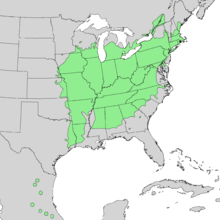
Back Карыя авальная Byelorussian Carya ovata CEB Ořechovec vejčitý Czech Schuppenrinden-Hickory German Carya ovata Spanish Valkohikkori Finnish Caryer ovale French Fehér hikoridió Hungarian Skihickory NB Orzesznik pięciolistkowy Polish
| Shagbark hickory | |
|---|---|

| |
| Scientific classification | |
| Kingdom: | Plantae |
| Clade: | Tracheophytes |
| Clade: | Angiosperms |
| Clade: | Eudicots |
| Clade: | Rosids |
| Order: | Fagales |
| Family: | Juglandaceae |
| Genus: | Carya |
| Section: | Carya sect. Carya |
| Species: | C. ovata
|
| Binomial name | |
| Carya ovata | |

| |
| Natural range of Carya ovata | |
Carya ovata, the shagbark hickory, is a common hickory in the Eastern United States and southeast Canada. It is a large, deciduous tree, growing well over 100 ft (30 m) tall, and can live more than 350[3] years. The tallest measured shagbark, located in Savage Gulf, Tennessee, is over 150 ft (46 m) tall [citation needed]. Mature shagbarks are easy to recognize because, as their name implies, they have shaggy bark. This characteristic is, however, only found on mature trees; young specimens have smooth bark.
The shagbark hickory's nut is edible and has a nutty taste. The leaves are 30–60 cm (12–24 in) long, pinnate, with five (rarely three or seven) leaflets, the terminal three leaflets much larger than the basal pair. The shagbark hickory is monoecious. Staminate flowers are borne on long-stalked catkins at the tip of old wood or in the axils of the previous season's leaves. Pistillate flowers occur in short terminal spikes.[4] The fruit is a drupe 2.5 to 4.0 cm (1 to 1+1⁄2 in) long, an edible nut with a hard, bony shell, contained in a thick, green four-sectioned husk which turns dark and splits off at maturity in the fall.[5] The terminal buds on the shagbark hickory are large and covered with loose scales.[6] Shagbark hickory nuts were a significant food source for the Algonquins. Red squirrels, gray squirrels, raccoons, chipmunks, and mice are consumers of hickory nuts.[7] Other consumers include black bears, gray and red foxes, rabbits, and bird species such as mallards, wood ducks, bobwhites, and wild turkey.[8]
The two varieties are:
- Carya ovata var. ovata (northern shagbark hickory) has its largest leaflets over 20 cm (8 in) long and nuts 3.0–4.0 cm (1+1⁄8–1+5⁄8 in) long.
- Carya ovata var. australis (southern shagbark hickory or Carolina hickory) has its largest leaflets under 20 cm (8 in) long and nuts 2.5–3.0 cm (1–1+1⁄8 in) long.
Some sources regard southern shagbark hickory as the separate species Carya carolinae-septentrionalis.[9]
- ^ Stritch, L. (2018). "Carya ovata". IUCN Red List of Threatened Species. 2018: e.T62019649A62019651. doi:10.2305/IUCN.UK.2018-1.RLTS.T62019649A62019651.en. Retrieved 29 January 2024.
- ^ "NatureServe Explorer 2.0 - Carya ovata, Shagbark Hickory". explorer.natureserve.org. Retrieved 6 May 2020.
- ^ "Eastern OLDLIST: A database of maximum tree ages for Eastern North America".
- ^ Tirmenstein, D. A. 1991. "Carya ovata." In: Fire Effects Information System [Online]. U.S. Department of Agriculture, Forest Service, Rocky Mountain Research Station, Fire Sciences Laboratory (Producer).[1]. Retrieved 2013-08-10.
- ^ Hilton Pond Center: Shaggybark Tree. Retrieved 2013-08-10.
- ^ Barnes, Burton V.; Wagner, Jr., Warren H. (2004). Michigan trees: a Guide to the Trees of the Great Lakes Region (Revised and updated ed.). Ann Arbor: University of Michigan Press. pp. 272–273. ISBN 0-472-08921-8.
- ^ Beaulieu, David. "Growing Shagbark Hickories, Harvesting Hickory Nuts". about.com. Archived from the original on 2013-05-13. Retrieved 2013-08-10.
- ^ "Shagbark Hickory Tree". cirrusimage.com. Red Planet Inc. Retrieved 2013-08-10.
- ^ Bioimages: Carya carolinae-septentrionalis Archived 2006-02-16 at the Wayback Machine. Retrieved 2013-08-10.

